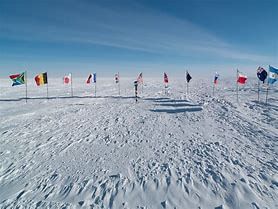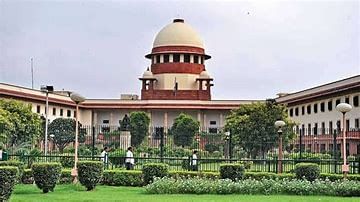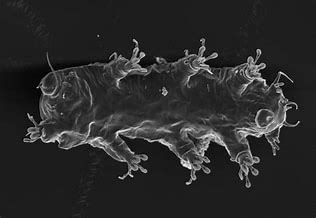UPSC Daily Current Affairs- 3rd May 2024 | Current Affairs & Hindu Analysis: Daily, Weekly & Monthly PDF Download
GS-I
To the South Pole – Antarctica
Subject: GeographySource: BBC

Why in News?
The Antarctic Treaty has sparked debates among policymakers, scientists, and the public as they consider environmental conservation, economic interests, and geopolitical concerns in Antarctica.
About Antarctica
- Antarctica is the fifth-largest continent, spanning approximately 14 million square km.
- It lies entirely within the Antarctic Circle, close to the South Pole.
- It stands as the coldest, driest, and windiest continent globally.
- The interior of Antarctica is a polar desert that receives minimal precipitation, mainly as snowfall.
- The Antarctic Ice Sheet is Earth's largest ice mass, holding about 70% of the planet's freshwater.
Territorial Claims on Antarctica
- Argentina: Claims Argentine Antarctica.
- Australia: Claims the Australian Antarctic Territory.
- Chile: Claims the Chilean Antarctic Territory.
- France: Claims Adélie Land.
- New Zealand: Claims the Ross Dependency.
- Norway: Claims Queen Maud Land.
- United Kingdom: Claims the British Antarctic Territory.
- United States: Claims the Marie Byrd Land.
India’s Antarctic Outreach
- India initiated its Antarctic Program in 1981, managed by the National Centre for Polar and Ocean Research.
- Through research bases like Dakshin Gangotri (1983), Maitri (1989), and Bharati (2012), India actively contributes to Antarctic exploration.
- India’s presence in Antarctica includes a Post Office established in 1984, aiding communication and research logistics.
Moon occulting the Antares (Jyeshtha)
Subject: Geography
Source: The Hindu

Recent Event:
The Indian Institute of Astrophysics in Bengaluru observed the moon passing in front of Antares, a prominent red star.
- The moon periodically conceals bright stars like Antares and planets as it completes its monthly orbit around Earth.
About Antares (Jyeshtha):
- Antares, also known as 'Alpha Scorpii,' is a red supergiant star situated in the Scorpius constellation.
- It is visible in the southern sky during the summer months in the northern hemisphere and is commonly dubbed the 'heart of the scorpion' due to its position and distinct red hue.
- With an estimated diameter around 700 times that of the Sun, it is a massive star.
- Its unique red color stems from a relatively low surface temperature compared to other stars.
- Antares lies approximately 550 light-years away from Earth, making it one of the closest red supergiants to our solar system.
Understanding Occultation:
- Occultation refers to the complete or partial obstruction of light from a celestial body as it moves behind another object.
- An exemplar of occultation is a solar eclipse, which is technically a lunar occultation of the sun.
GS-II
Recognize ‘this leave’ as a woman’s right
Subject: Polity and Governance
Source: The Hindu

Why in News?
The DMK's 2024 election manifesto in Tamil Nadu pledges to advocate for a law mandating menstrual leave for women, promoting gender equality and women's welfare.
Tracking Regional Progress
Indian States:
- Kerala Sahitya Academy mentioned the need for period leave for students in 1912.
- Introduced menstrual and maternity leave for students above 18 in January 2023.
- Bihar granted government employees two-day menstrual leave in 1992.
Asian Countries:
- Japan, Indonesia, South Korea, Taiwan, and Vietnam have implemented menstrual leave.
- Progress in Asian countries lags behind western nations like Sweden and Spain.
Global Scenario:
- International Labour Organization urged nations to recognize menstrual leave in 2003.
- World Health Organization recognizes World Menstrual Hygiene Day since 2014.
- India's new Social Security code in 2020 did not include menstrual leave.
Evidence related to impact:
- Instances of women opting for hysterectomies due to menstrual-related absences in Maharashtra and Telangana.
Legal Initiatives in India:
- Private Member Bills on menstrual leave introduced in Tamil Nadu, Arunachal Pradesh, and Kerala by various MPs.
- Supreme Court of India's stance on menstrual leave as a policy matter in 2023.
Way Forward:
- Advocate for legislative changes at state and national levels to ensure menstrual leave for women.
- Launch awareness campaigns to destigmatize menstruation and educate on its biological and social aspects.
Chargesheet
Subject: Polity and Governance
Source: Hindustan Times

Why in News?
Supreme Court recently emphasized the importance of a well-detailed chargesheet for clarity in criminal cases.
About Chargesheet:
- A chargesheet is the final report submitted under Section 173 of the Code of Criminal Procedure after the investigation.
- It encompasses records from the start of the investigation to the final report preparation.
- Submission of the chargesheet initiates prosecution proceedings against the accused.
- The report must follow the format specified by the state government.
Key Contents of a Chargesheet:
- Names of the parties involved.
- Description of the offense and the alleged offender.
- Details of individuals associated with the events.
- Information on the arrest of the accused and any related custody matters.
Benefits of a Chargesheet:
- Includes statements from both the accused and witnesses.
- Signals the commencement of a criminal trial.
- Specifies the charges against the accused for the court to proceed.
- Assists the accused in seeking bail by clearly outlining the offenses.
Time Limit for Filing a Charge Sheet:
- Must be filed within 60 days for cases under lower courts and 90 days for cases under Court of Sessions.
- Delay in filing grants the accused the right to default bail.
Compulsory Nature of Filing a Chargesheet:
- Mandatory for cognizable offenses post-FIR filing either by police or court orders.
- Not obligatory for non-cognizable offenses unless court-ordered investigation.
Understanding Cognizable Offenses:
- Classified as crimes allowing police to investigate without a magistrate's order and arrest without a warrant.
- Police are directly responsible for immediate action upon receiving complaints in such cases.
Commission on Population and Development
Subject: International Relations
Source: UN News

Why in News?
The Permanent Mission of India to the United Nations and the Ministry of Panchayati Raj, in collaboration with the United Nations Population Fund is organizing event titled “Localizing the SDGs: Women in Local Governance in India Lead the Way” during the 57th Session of the Commission on Population and Development (CPD57).
Establishment and Composition
- The Commission on Population and Development was formed in 1946 by the Economic and Social Council (ECOSOC).
- In 1994, the General Assembly renamed it as the Commission on Population and Development.
- It consists of 47 member countries.
- Member countries are elected by the ECOSOC for a four-year term based on geographic distribution.
Role and Functioning
- Operates as a three-tiered intergovernmental mechanism.
- Plays a crucial role in monitoring the implementation of action plans at various levels.
- Provides guidance to the Economic and Social Council.
- Initially, meetings were held every two or three years, but since 1994, it convenes annually.
United Nations Population Fund
Overview
- Established in 1968 as an international development agency.
- Supports projects in the areas of population, sexual, and reproductive health.
- Officially renamed as the United Nations Population Fund in 1987.
- Retained the original abbreviation UNFPA (United Nations Fund for Population Activities).
Functions
- Not directly involved in primary data collection.
- Offers technical and financial assistance for statistical activities like censuses and surveys.
- Headquartered in New York.
 |
Download the notes
UPSC Daily Current Affairs- 3rd May 2024
|
Download as PDF |
GS-III
A Computer Science Conundrum Transforming Healthcare
Subject: Science and Technology
Source: The Hindu

Why in News?
Recent challenges faced by the Indian healthcare system are becoming increasingly intricate, posing significant hurdles due to their complexity and potential resource limitations.
Quick Problems vs. Complex Problems in Healthcare
Healthcare scenarios often involve complex issues. For instance, scheduling in a hospital demands meticulous consideration of numerous variables like staff availability, medical emergency urgencies, and unforeseen changes.
- Quick Problems vs. Complex Problems: The core question revolves around whether there exists a rapid solution pathway for complex healthcare issues akin to how quick problems are addressed.
Implications for Healthcare System
The integration of computer science solutions can revolutionize healthcare delivery, offering benefits such as:
- Combatting Antibiotic Resistance: Swift genetic analysis aiding in more precise antibiotic prescriptions to counter resistance patterns.
- Enhancing Cancer Treatments: Timely identification of tailored cancer therapies to address diverse mutations and treatment alternatives.
- Streamlining Insurance Operations: Efficient resolution of complex problems can enhance premium accuracy and fairness in insurance packages.
- Optimizing Government Health Expenditure: Effective problem-solving can ensure optimal allocation of healthcare funds, diminishing wastage and promoting universal health coverage.
- Resource Optimization and Health Outcomes: Improved efficiency in addressing healthcare complexities can alleviate resource constraints and elevate overall health outcomes.
Future Strategies
Governmental interventions can shape the future of healthcare by:
- Promoting Technological Responsibility: Encouraging the ethical use of technology in healthcare and endorsing evidence-based approaches.
- Data Security and Transparency: Setting data protection standards, ensuring transparent algorithmic decision-making, and fostering equal healthcare access.
Batillipes chandrayaani
Subject: Environment
Source: India Times

Why in News?
A recent discovery of a new species of marine tardigrade from the southeast coast of Tamil Nadu named Batillipes chandrayaani, after the Chandrayaan-3 mission.
About Batillipes chandrayaani:
- Discovered in the intertidal beach sediments at Mandapam in Tamil Nadu.
- Characteristics:
- Similar in size to other tardigrades, measuring 0.15 millimeters in length and 0.04 millimeters in width.
- Distinct features include a trapezoid-shaped head and four pairs of legs with sharp-tipped sensory spines.
- Both sexes exhibit similar morphology and size.
- It is recognized as the 39th species classified under the genus Batillipes.
Understanding Tardigrades:
- Tardigrades, often referred to as 'water bears,' are microscopic organisms.
- Marine tardigrades represent 17% of all known tardigrade species and are distributed across various oceans.
- Despite their minuscule size, these micro-metazoans are renowned for their exceptional resilience, surviving through mass extinctions and showcasing remarkable survival capabilities.
Why are Indian spices facing the heat?
Subject: Environment and Ecology
Source: The Hindu

Why in News?
Many investigations are underway regarding potential contamination of spice mixes from popular Indian brands like MDH and Everest Masalas.
- The Global Trade Research Initiative (GTRI) emphasized the significant export value of Indian spices, amounting to around $700 million, to key markets.
- Ethylene oxide is a colorless, flammable gas utilized as a disinfectant, fumigant, sterilizing agent, and insecticide either in its gaseous form or in non-explosive mixtures with gases like nitrogen or carbon dioxide.
- Some natural sources produce ETO, with ethylene oxide generated from ethylene in certain plants, water-logged soil, manure, and sewage sludge.
- ETO, a banned pesticide, is used as a sterilizing agent in the food industry, including spices, posing risks due to the formation of toxic compounds such as ethylene glycol.
- Long-term exposure to ETO is linked to health hazards like cancers such as lymphoma and leukemia, as evidenced by incidents involving Indian products contaminated with ethylene glycol.
- Hong Kong: Suspended sales of specific MDH and Everest spice blends due to high ETO levels.
- Singapore: Recalled Everest spice mix citing health risks from ETO.
- United States: FDA is investigating the situation.
- Maldives: Suspended sales of Everest and MDH spices.
- Australia: Collaborating with international bodies to address the issue.
- Bangladesh: Gathering information on potentially contaminated imports.
Lack of Standardized Protocol System
- The diverse food landscape in India and the absence of standardized monitoring hinder efficient ingredient tracing and risk assessment.
Lack of Database
- Many companies struggle with ingredient tracing due to inadequate recordkeeping, hindering risk assessment and compromising food safety.
- Small and medium-sized businesses face difficulties in traceability due to limited resources.
- The Food Safety Modernization Act (FSMA) mandates preventive controls and hazard analysis for food facilities, including spice manufacturers.
- The Spices Board introduced mandatory testing for consignments to select countries and issued guidelines to prevent ETO contamination.
- Recent measures include voluntary ETO testing, separate storage for ETO-treated products, and incorporating critical control points in hazard analysis.
- Enhanced Regulatory Oversight: Strengthen regulatory bodies like FSSAI for strict compliance with safety standards through inspections and enforcement actions.
- Improved Traceability Systems: Implement robust traceability mechanisms using technologies like blockchain and RFID to enhance transparency across the food supply chain.
|
39 videos|4857 docs|1054 tests
|
























